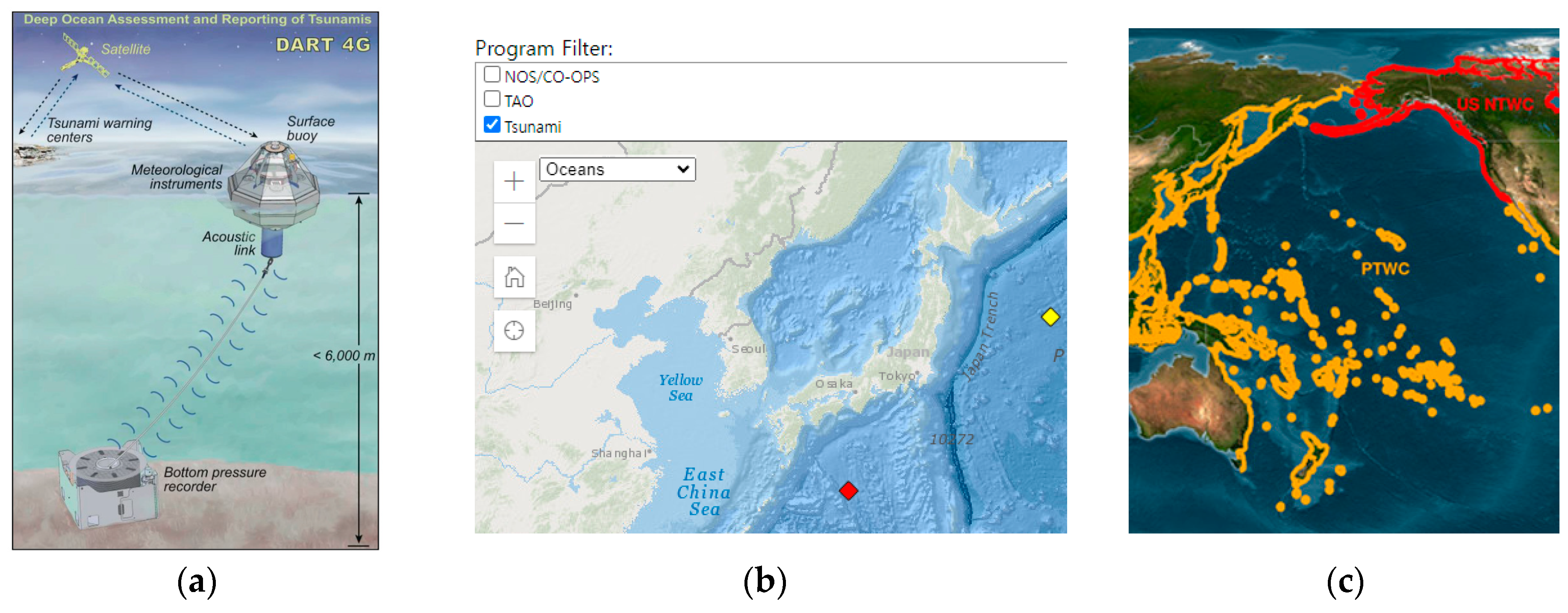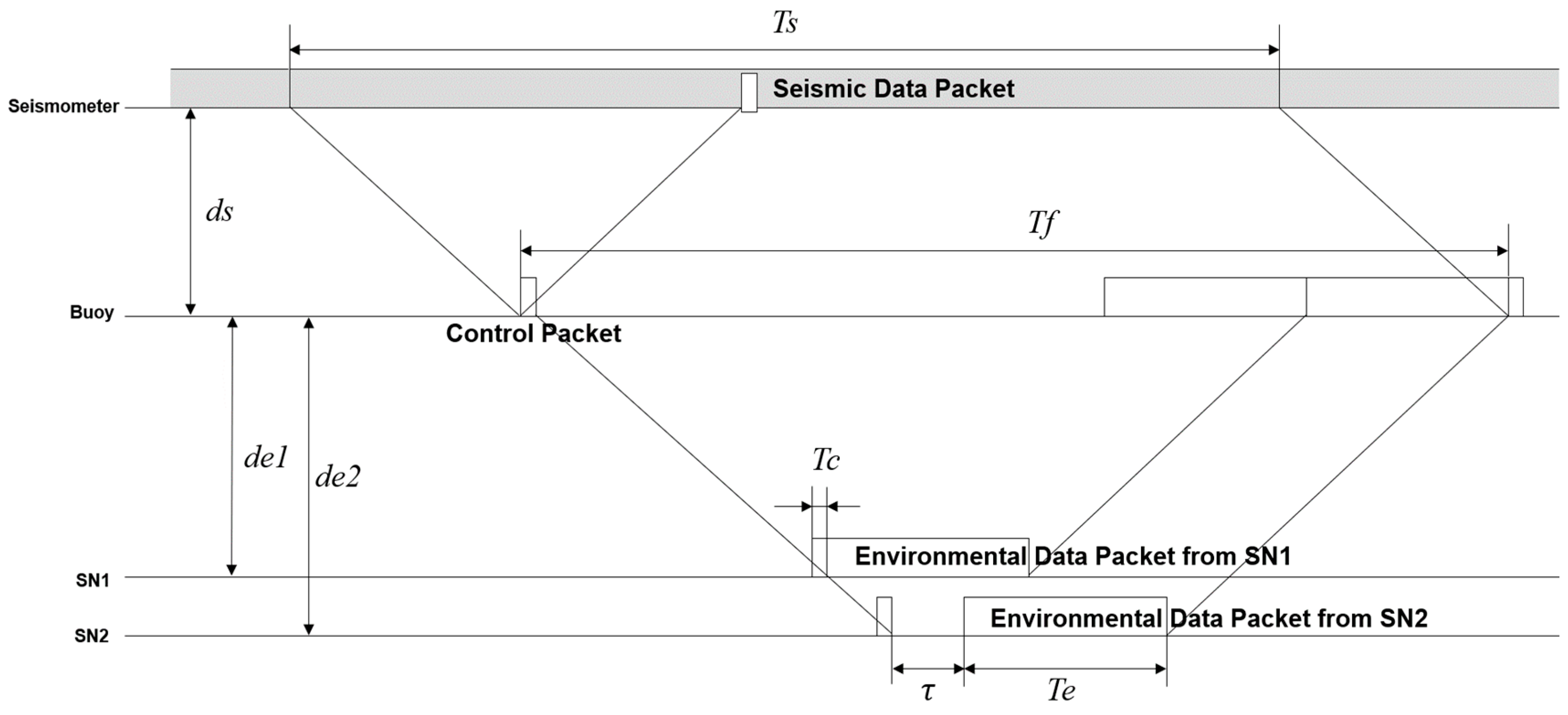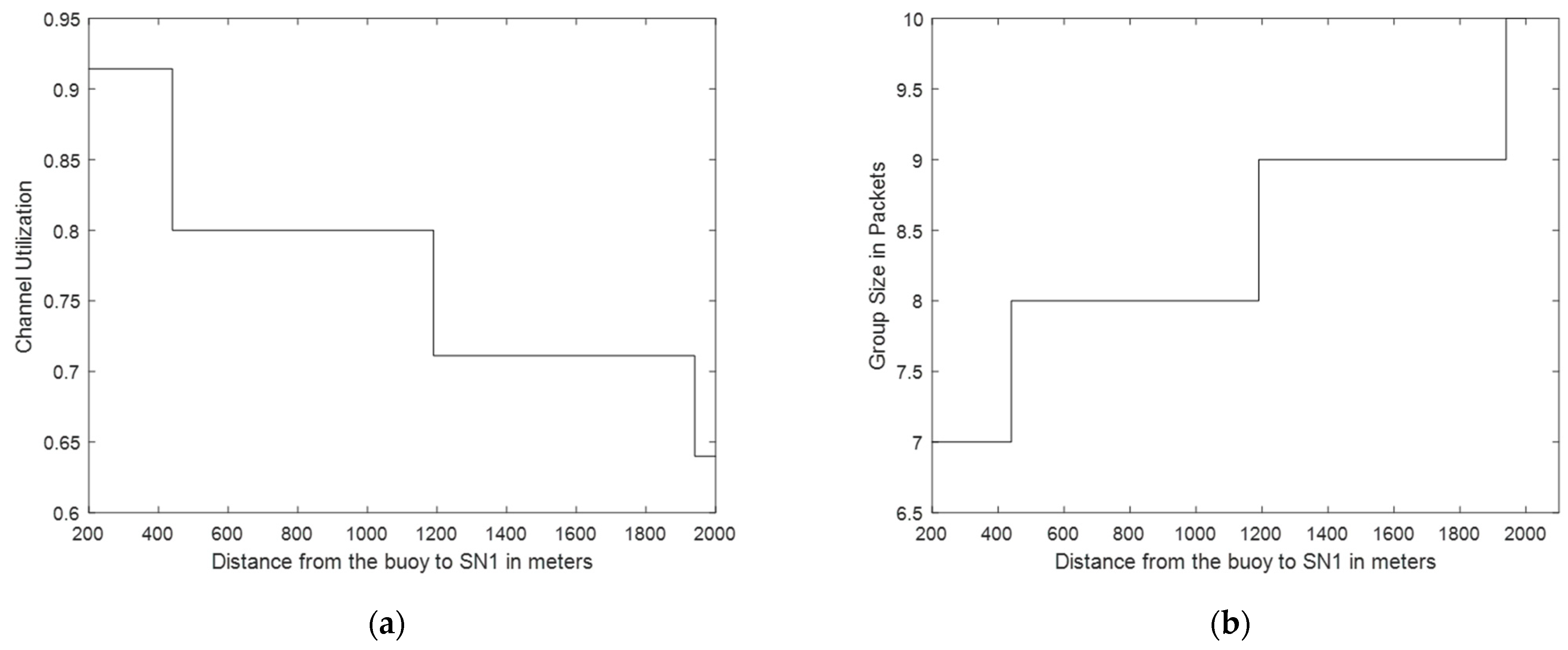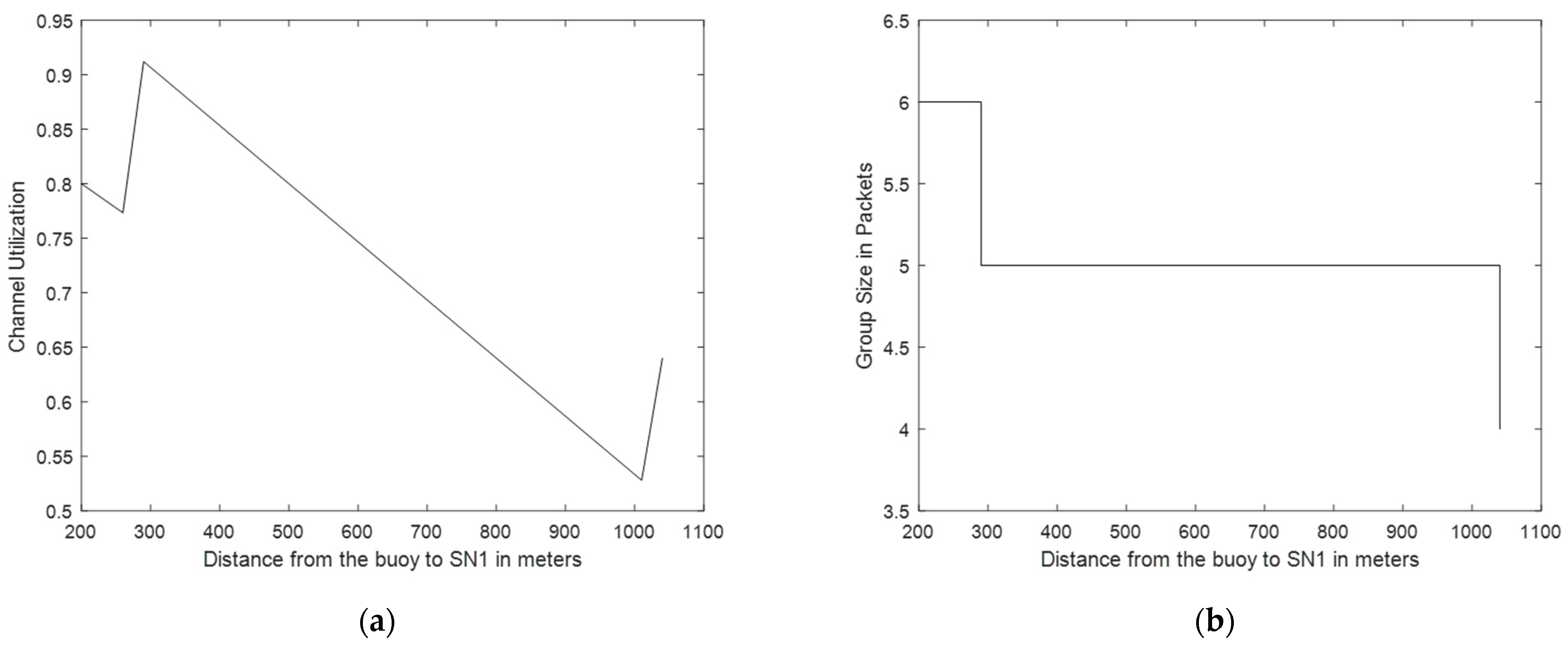Hybrid Duplex Medium Access Control Protocol for Tsunami Early Warning Systems in Underwater Networks
Abstract
1. Introduction
- This paper introduces a MAC protocol which supports hybrid duplexing, tailored to the characteristics of a tsunami early warning system in which heterogeneous data is collected.
- The proposed protocol is specifically designed to meet project requirements suited for underwater channel evaluation in Korea.
- This paper provides mathematical definition of the protocol, predicts its performance, and verifies it using a simulation tool, OMnET++ (version 6.0.3).
- This paper focuses on MAC protocol design, with emphasis on the influence of parameters at the medium access level.
- Discussion regarding physical layer and RF parameters are beyond the scope of this study.
- Time synchronization is assumed to be supported by the physical layer.
- The seismometer data size value is provided by an independent institution; discussion related to this are beyond the scope of this paper.
2. Literature Review
- To implement national- or local-level tsunami warning systems using wireless acoustic communication instead of cable-based systems.
- To achieve fast and reliable data transmission via wireless acoustic communications.
- To develop domestically produced early warning systems.
3. Hybrid Duplex MAC Protocol Design
3.1. Data Transmission Requirements
- The project provides accurate time synchronization across all the nodes before deployment;
- The number of nodes in the network is known prior to deployment;
- The deployment map (node locations) is determined before deployment;
- The buoy is equipped with two separate receiver modems operating on different frequencies.
3.2. Group ARQ Scheme for HDMAC
3.3. Theoretical Channel Utilization of HDMAC
4. Simulation Results
5. Conclusions
Author Contributions
Funding
Data Availability Statement
Conflicts of Interest
Appendix A. ARQ Performance Comparison Between One Tx and Rx
| Symbol | Definition |
|---|---|
| N | Packet size in bits |
| Tp | Packet duration in sec |
| R | Channel bit rate in bps |
| Tb | Bit duration in sec (1/R) |
| Td | Propagation delay in sec |
| Tack | Negligible (Tack <<< Tp) |
| d | Distance between one Tx and one Rx |
| c | 1500 m/s |
| M | ARQ group size |
| p | Probability of packet error |
| T(M) | Total time needed for transmission of a group of M packets and reception of the corresponding group of ACKs |
References
- National Oceanic and Atmospheric Administration (NOAA); National Ocean Service. What Is a Tsunami? Available online: https://oceanservice.noaa.gov/facts/tsunami.html (accessed on 5 October 2024).
- Nobuhito, M.; Kenji, S.; Daniel, C.; Katsuichiro, G.; Patrico, A.C.; Tung, C.H.; Fumikiko, I.; Tori, T.; Patrick, L.; Takuya, M.; et al. Giant tsunami monitoring, early warning and hazard assessment. Nat. Rev. Earth Environ. 2022, 3, 557–572. [Google Scholar]
- Wallemacq, P.; Rowena, H. Economic Losses, Poverty & Disasters: 1998–2017; United Nations office for Disaster Risk Reduction: Geneva, Switzerland, 2018. [Google Scholar]
- Selva, J.; Lorito, S.; Volpe, M.; Romano, F.; Tonini, R.; Perfetti, P.; Bernardi, F.; Taroni, M.; Scala, A.; Babeyko, A.; et al. Probabilistic tsunami forecasting for early warning. Nat. Commun. 2021, 12, 5677. [Google Scholar] [CrossRef] [PubMed]
- Kenji, S.; Masami, O.; Kuniaki, A. Tide gauge response to tsunamis: Measurement at 40 tide gauge station in Japan. J. Mar. Res. 1988, 46, 557–571. [Google Scholar]
- Merrifield, M.A.; Firing, Y.L.; Aarup, T.; Agricole, W.; Brundrit, G.; Chang, S.D.; Farre, R.; Kilonsky, B.; Knight, W.; Kong, L.; et al. Tide gauge observation of the Indian Ocean tsunami December 26, 2004. Geophys. Res. Lett. 2005, 32. [Google Scholar] [CrossRef]
- Jinwon, K.; Bogeun, S.; Sangman, H.; Kiha, C.; Haklim, K.; Hojun, L. Chirp-based Frequency Shift Keying for Underwater Acoustic Communications. In Proceedings of the 5th International Conference on Ubiquitous and Future Networks (ICUFN), Budapest, Hungary, 2 July 2024. [Google Scholar]
- Kwang, Y.C.; Hojun, L.; Sung, H.P.; Taeho, I.; Haklim, K. OFDM Signals Underwater Experiments and Analysis in East Sea of South Korea. In Proceedings of the IEEE 7th International Conference on Information Technology, Information Systems and Electrical Engineering (ICITISEE), Purwokerto, Indonesia, 29 November 2023. [Google Scholar]
- Sangman, H.; Kyeon, K.; Sung, H.P.; Haklim, K.; Hojun, L. Algorithm to Improve Synchronization of USBL Underwater Multipath and Doppler Environments. In Proceedings of the IEEE 7th International Conference on Information Technology, Information Systems and Electrical Engineering (ICITISEE), Purwokerto, Indonesia, 29 November 2023. [Google Scholar]
- Sangman, H.; Sungho, K.; Haklim, K.; Hojun, L. Deep Learning-based Range Estimation with Sound Speed Profile. In Proceedings of the IEEE 5th Eurasia Conference on IOT, Communication and Engineering (ECICE), Yunlin, Taiwan, 27 October 2023. [Google Scholar]
- Haklim, K.; Hojun, L.; Minhyuk, C.; Sungho, K.; Seyeon, K.; Taeho, I. Base Station-based Underwater Communication Network. In Proceedings of the OCEANS 2023—Limerick, Limerick, Ireland, 5 October 2023. [Google Scholar]
- Hojun, L.; Kyewon, K.; Taegeon, C.; Haklim, K. Deep Learning-based Ultra Short Baseline Underwater Positioning. In Proceedings of the International Conference on Artificial Intelligence in Information and Communication (ICAIIC), Bali, Indonesia, 20 February 2023. [Google Scholar]
- Sungho, K.; Sangman, H.; Sung, H.P.; Hojun, L.; Taeho, I. Underwater LFM Signal Communication Analysis from the On-Site Experiments in West Sea. In Proceedings of the IEEE 7th International Conference on Information Technology, Information Systems and Electrical Engineering (ICITISEE), Purwokerto, Indonesia, 29 November 2023. [Google Scholar]
- Taegeon, C.; Kanhoon, C.; Kwang, Y.C.; Taeho, I. Design of Underwater Communication and Demodulation Technology for High-Performance Underwater Acoustic Modem. In Proceedings of the International Conference on Ubiquitous and Future Networks (ICFUN), Budapest, Hungary, 2 July 2024. [Google Scholar]
- UNESCO Tsunami Programme, End-to-End Warning Systems. Available online: https://tsunami.ioc.unesco.org/en/warningsystems (accessed on 5 October 2024).
- Bernard, E.; Meinig, C. History and Future of Deep-ocean Tsunami Measurements. In Proceedings of the OCEANS’11 MTS/IEEE KONA, Waikoloa, HI, USA, 19–22 September 2011. [Google Scholar]
- Lawson, R.A.; Graham, D.; Stalin, S.; Meinig, C.; Tagawa, D.; Lawrence, S.N. From Research to Commercial Operations: The Next Generation Easy-to-Deploy (EDT) Tsunami Assessment Buoy. In Proceedings of the OCEANS 2011 IEEE, Santander, Spain, 6–9 June 2011. [Google Scholar]
- National Data Buoy Center. Available online: https://www.ndbc.noaa.gov/obs.shtml?lat=13&lon=-173&zoom=2&pgm=tsunami (accessed on 6 October 2024).
- PMEL. DART4 Brochure. Available online: https://nctr.pmel.noaa.gov/Pdf/brochures/dart4G_Brochure.pdf (accessed on 6 October 2024).
- Peter, P.F. The US Tsunami Program: A Brief Overview; Congressional Research Service: Washington, DC, USA, 2015.
- Toshihiko, K. Japan Trench Earthquake and Tsunami Monitoring Network of Cable-Linked 150 Ocean Bottom Observatories and its Impact to Earth Disaster Science. In Proceedings of the IEEE International Underwater Technology Symposium (UT), Tokyo, Japan, 5 March 2013. [Google Scholar]
- Kaneda, Y.; Kawaguchi, K.; Araki, E.; Matsumoto, H.; Nakamura, T.; Kamiya, S.; Ariyoshi, K.; Hori, T.; Baba, T.; Takahashi, N. Development and application of an advanced ocean floor network systems for megathrust earthquakes and tsunamis. In Seafloor Observatories; Springer: Berlin, Germany, 2015; pp. 643–662. [Google Scholar]
- Chris, R.B.; Mairi, M.R.; Adam, Z. The Neptune Canada regional cabled ocean observatory. Technology 2008, 50, 10–14. [Google Scholar]
- Dharmawan, W.; Diana, M.; Tuntari, B.; Astawa, I.M.; Rahardjo, S.; Nambo, H. Tsunami tide prediction in shallow water using recurrent neural networks: Model implementation in the Indonesia Tsunami early warning system. J. Reliab. Intell. Environ. 2023, 10, 117–195. [Google Scholar]
- Michael, A.P.; Yudi, A.; Wahyu, W.P.; Joko, W.; Andi, E.S. Introduction to Indonesian Cable-based Subsea Tsunameter. In Proceedings of the IEEE Underwater Technology (UT), Tokyo, Japan, 6 March 2023. [Google Scholar]
- Han, X.; Zack, J.S.; Jiaxuan, L.; Zhongwen, Z. Detect of earthquake infragravity and tsunami waves with underwater distributed acoustic sensing. Geophys. Res. Lett. 2024, 51, e2023GL106767. [Google Scholar]
- Bernard, E.; Meinig, C.; Titov, V.V.; Wei, Y. 50 Years of PMEL Tsunami Research and Development. Oceanography 2023, 36, 175–185. [Google Scholar] [CrossRef]
- National Research Council. Tsunami detection and forecasting In Tsunami Warning and Preparedness; National Academies Press: Washington, DC, USA, 2011; pp. 109–163. [Google Scholar]
- Eddie, B.; Vasily, T. Evolution of tsunami warning systems and products. Philos. Trans. R. Soc. A Math. Phys. Eng. Sci. 2015, 373, 20140371. [Google Scholar]
- Groupo Elcnor-Deimos. A Tsunami Space-Based Early Warning System. Available online: https://elecnor-deimos.com/tsunami-prevention-gnss-r/ (accessed on 5 October 2024).
- Eunju, L.; Taehwa, J.; Jichang, K.; Sungwon, S. A study of the optimal deployment of tsunami observation instruments in Korea. J. Ocean. Eng. Technol. 2019, 33, 607–614. [Google Scholar]
- Danielle, F.S.; Sara, K.M.; Christa, V.H.; Monica, D.K.; John, O.; Shuichi, K.; Kate, M.; Daniel, M.; Takane, H.; Elizabeth, V.; et al. Long-term ocean observing coupled with community engagement improves tsunami early warning. Oceanography 2021, 34, 70–77. [Google Scholar]
- Hobin, L.; Younghee, K. A dataset of seismic sensor responses of South Korea seismic stations. J. Geol. Soc. Korea 2020, 56, 515–524. [Google Scholar]
- Nils, M.; Paul, M.; Yoriy, V.Z. TDA-MAC: TDMA without clock synchronization in underwater acoustic networks. IEEE Access 2017, 6, 1091–1108. [Google Scholar]
- Rameez, A.; Milica, S. Reliable Communication Using Packet Coding for Underwater Acoustic Channels. In Proceedings of the IEEE 17th International Workshop on Signal Processing Advances in Wireless Communications (SPAWC), Edinburgh, UK, 3 July 2016. [Google Scholar]
- Abramson, N. The throughput of packet broadcasting channels. IEEE Trans. Commun. 1977, 25, 117–128. [Google Scholar] [CrossRef]
- Huseyin, U.Y.; Vehbi, C.G.; Bulet, T. Packet size optimization for lifetime maximization in underwater acoustic sensor networks. IEEE Trans. Ind. Inform. 2018, 15, 719–729. [Google Scholar]
- Stefano, B.; Chiara, P.; Roberto, P.; Milica, S. Choosing the Packet Size in Multi-hop Underwater Networks. In Proceedings of the OCEANS’10, Sydney, Australia, 24–27 May 2010. [Google Scholar]
- OMNet++. Available online: https://omnetpp.org/ (accessed on 26 October 2024).
- Narendra, M.M.; Savita, C. Comparative Study of Simulators for Vehicular Ad-hoc Networks (VANETs). Int. J. Emerg. Technol. Adv. Eng. 2014, 4, 528–537. [Google Scholar]
- Sohaib, M.; Mahak, M.; Hira, M.; Durr, E.A.; Muhammad, A.K. Which Simulator to Choose for Next Generation Wireless Network Simulations? NS-3 or OMNeT++. Eng. Proc. 2023, 46, 36. [Google Scholar] [CrossRef]
- Discovery of Sound in the Sea. The University of Rhode Island. Available online: https://dosits.org/science/movement/how-fast-does-sound-travel/ (accessed on 5 October 2024).












| Symbol | Definition |
|---|---|
| Tf | Frame duration in seconds |
| Te | Environmental packet duration in seconds |
| Ts | Seismometer packet duration in seconds |
| Tc | Control packet duration in seconds |
| Be | Environmental packet size in bits |
| Bs | Seismometer packet size in bits |
| Bc | Control packet size in bits |
| Rs | Channel data rate in bps at 16 kHz bandwidth |
| Re | Channel data rate in bps at 4 kHz bandwidth |
| ds | Distance from the buoy to the seismometer in meters |
| de1 | Distance from the buoy to SN1 in meters |
| de2 | Distance from the buoy to SN2 in meters |
| c | Acoustic wave propagation speed (1500 m/s) |
| τ | SN2 waiting time (s) |
| Symbol | Definition |
|---|---|
| M | Number of packets in a group for ARQ |
| λ | Rounding up time in Tf for the seismometer packets |
| Symbol | Parameter Value |
|---|---|
| Rs | 5000 bps |
| Re | 1250 bps |
| ds | 0 to 200 m |
| de1 | 200 to 2000 m |
| de2 | 2000 m |
| Bs | 5000 bits |
| Bc | 32 bits |
| c | 1500 m/s |
Disclaimer/Publisher’s Note: The statements, opinions and data contained in all publications are solely those of the individual author(s) and contributor(s) and not of MDPI and/or the editor(s). MDPI and/or the editor(s) disclaim responsibility for any injury to people or property resulting from any ideas, methods, instructions or products referred to in the content. |
© 2024 by the authors. Licensee MDPI, Basel, Switzerland. This article is an open access article distributed under the terms and conditions of the Creative Commons Attribution (CC BY) license (https://creativecommons.org/licenses/by/4.0/).
Share and Cite
Park, S.H.; Choi, Y.J.; Im, T.H. Hybrid Duplex Medium Access Control Protocol for Tsunami Early Warning Systems in Underwater Networks. Electronics 2024, 13, 4288. https://doi.org/10.3390/electronics13214288
Park SH, Choi YJ, Im TH. Hybrid Duplex Medium Access Control Protocol for Tsunami Early Warning Systems in Underwater Networks. Electronics. 2024; 13(21):4288. https://doi.org/10.3390/electronics13214288
Chicago/Turabian StylePark, Sung Hyun, Ye Je Choi, and Tae Ho Im. 2024. "Hybrid Duplex Medium Access Control Protocol for Tsunami Early Warning Systems in Underwater Networks" Electronics 13, no. 21: 4288. https://doi.org/10.3390/electronics13214288
APA StylePark, S. H., Choi, Y. J., & Im, T. H. (2024). Hybrid Duplex Medium Access Control Protocol for Tsunami Early Warning Systems in Underwater Networks. Electronics, 13(21), 4288. https://doi.org/10.3390/electronics13214288








